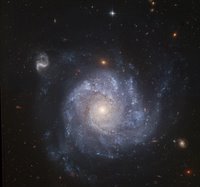Pinwheel (NGC 1309)
 Like a pinwheel in the wind, the spiral galaxy NGC 1309 presents its full face towards the Hubble Space Telescope (HST).
Like a pinwheel in the wind, the spiral galaxy NGC 1309 presents its full face towards the Hubble Space Telescope (HST).This image, a combination of visible and infrared observations, highlights several features of NGC 1309, which sits some 100 million light-years from Earth part of the Eridanus (the River) group of about 200 galaxies. The blue areas indicate star formation along the galaxy’s spiral arms, while wispy dust lanes wind their way into its yellow central nucleus.
Astronomers use NGC 1309 to measure the expansion rate of the universe, relying on a stellar explosion – a Type Ia supernova dubbed 2002fk – which lit up its galactic home in September 2002. Type Ia supernovas are useful because they allow astronomers to better measure distances of objects from each other.
For example, by comparing nearby Type Ia supernovae to more distant ones, researchers are were able to determine not only that the universe is expanding, but that the expansion is accelerating. However, the method only works if the distance to the host galaxies is known extremely well.
NGC 1309 also contains Cepheid variable stars, which shift in brightness at different rates, allowing astronomers to deduce their distance.








0 Comments:
Post a Comment
<< Home